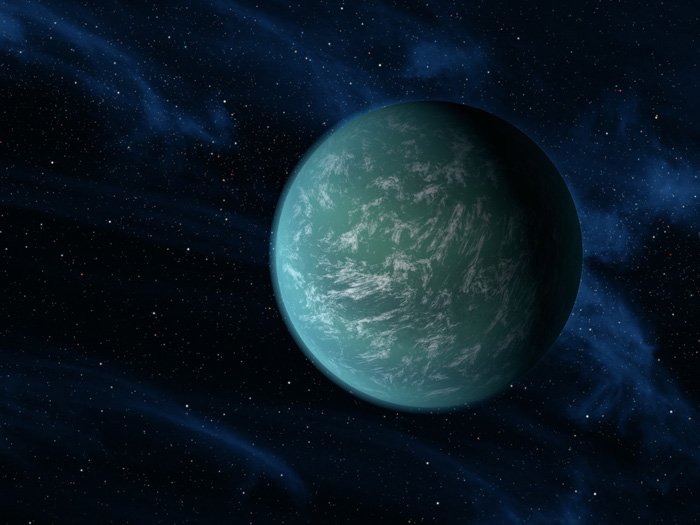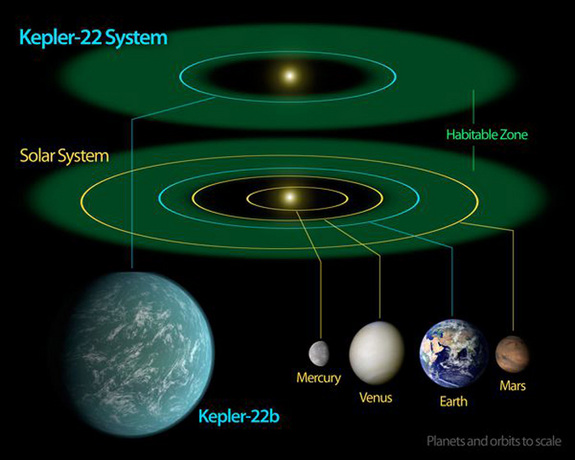
An artist’s conception of Kepler-22b, a planet known to be in the habitable zone of a sun-like star.
Credit: NASA/Ames/JPL-Caltech.
Kepler-22b is the first extra-solar planet, or exoplanet, that the Kepler Space Telescope found in the habitable zone of its star. It is believed to be a promising spot to search for life. But at 600 light-years away, further scrutiny of this world may require more powerful telescopes.
Announced in 2011, the planet is estimated at 2.4 times larger in diameter in Earth, with a comfortable average surface temperature of 72 degrees Fahrenheit (22 degrees Celsius).
Kepler since discovered numerous worlds that are close to Earth’s size, but investigators are still hoping to find a planet the same size as Earth and orbiting in the habitable zone of a star similar to our sun. [Infographic: NASA’s Planet-Hunting Kepler Telescope Explained ]
Discovery
NASA first announced Kepler-22b as part of a set of 54 habitable planet candidates in February 2011. All of these planets were found by theKepler Space Telescope . The telescope looks for alien worlds by measuring dips in the parent star’s light as the planet zooms across the star (from Earth’s point of view).
To confirm if a planet is actually true, it is best practice to do multiple observations, ideally from different observatories. By December, NASA was able to confirm Kepler-22b’s existence — and publish it in the Astrophysical Journal — both of which were announced as part of a larger press conference . At the conference, NASA announced Kepler had found more than 1,000 new exoplanet candidates, providing years of work to confirm the batch.
The planet is slightly larger than Earth, but has an orbit that is pretty similar (290 days to Earth’s 365). Kepler-22b also orbits a G-star class sun like our sun, but the exoplanet’s star is a little bit smaller and colder. Investigators praised the find as helping to fufill Kepler’s mission of finding another Earth.
“We’re getting closer and closer to discovering the so-called ‘Goldilocks planet,'” Pete Worden, director of NASA’s Ames Research Center in Moffett Field, Calif., said during the press conference.
A Kepler team member also suggested that the planet, at more than double Earth’s size, may not be able to host life on its surface. Instead, it could have an environment that is closer to Neptune: rocky core, large ocean.
“It’s not beyond the realm of possibility that life could exist in such an ocean,” said Natalie Batalha, the Kepler deputy science chief, in an interview with the Associated Press .

This diagram compares our solar system to the Kepler-22 system. The green area represents the habitable zone where water can exist in liquid form. Kepler-22’s star is a bit smaller than our sun, so its habitable zone is slightly closer in. The orbit of Kepler-22b around its star takes 289 days and is about 85 percent as large as Earth’s orbit.
Credit: NASA/Ames/JPLCal-tech.
Habitable zone searches
A few scientific papers have been produced since 2012 examining Kepler-22b in detail.
However, the habitability of Kepler-22b is not necessarily a sure thing. It is only listed as a potentially habitable planet at The Habitable Exoplanets Catalog (a project of the Planetary Habitability Laboratory of the University of Puerto Rico at Arecibo). It is included in a list of “optimistic” habitable planets that may not be rocky, may not include liquid water, or may orbit at the edge of the habitable zone.
More data on Kepler-22b is possible from archives of the Kepler space telescope, as not all the data has been examined yet. The telescope is still operational as of early 2016, but examining different areas of the sky. It has found many other potentially habitable worlds since Kepler-22b. Although the distance of these worlds makes it difficult to perform follow-ups, further work is possible using ground-based telescopes or future space observatories.
Comments are closed.